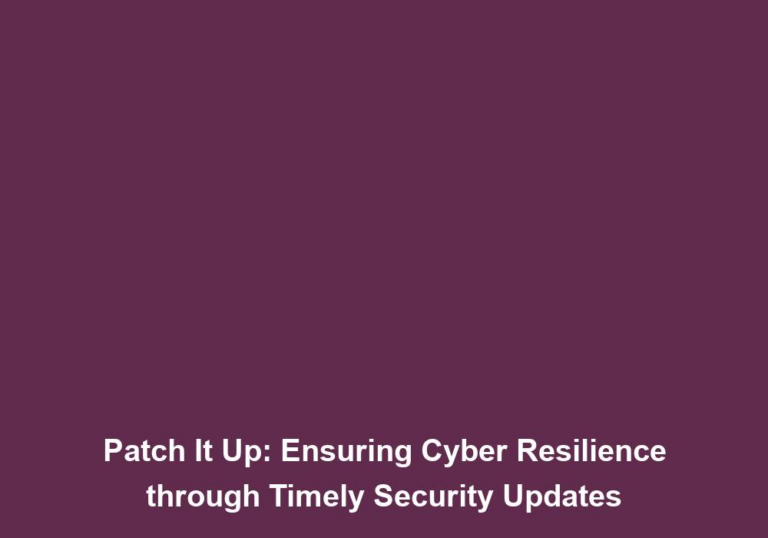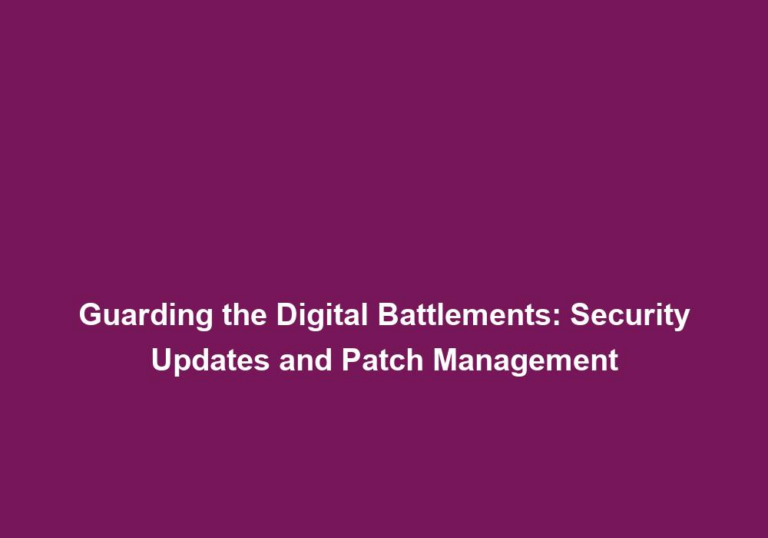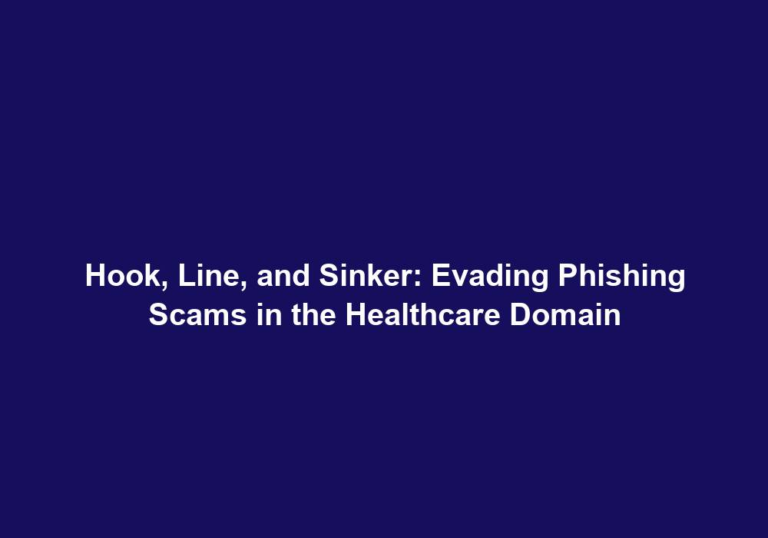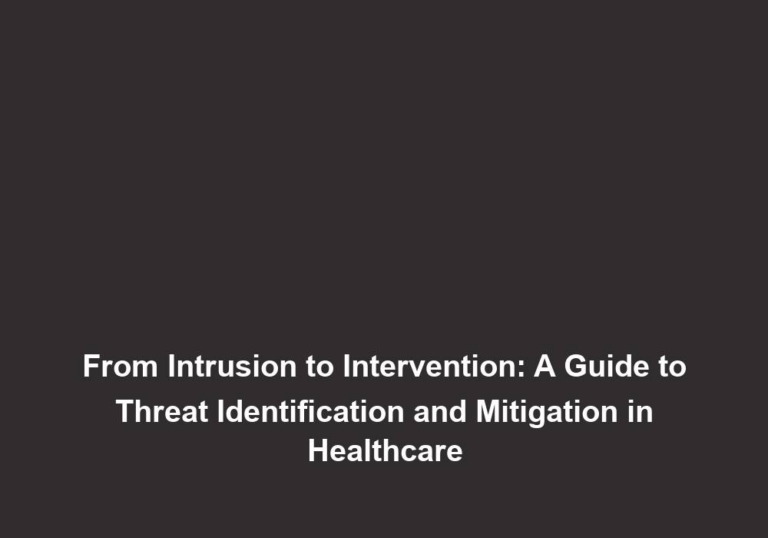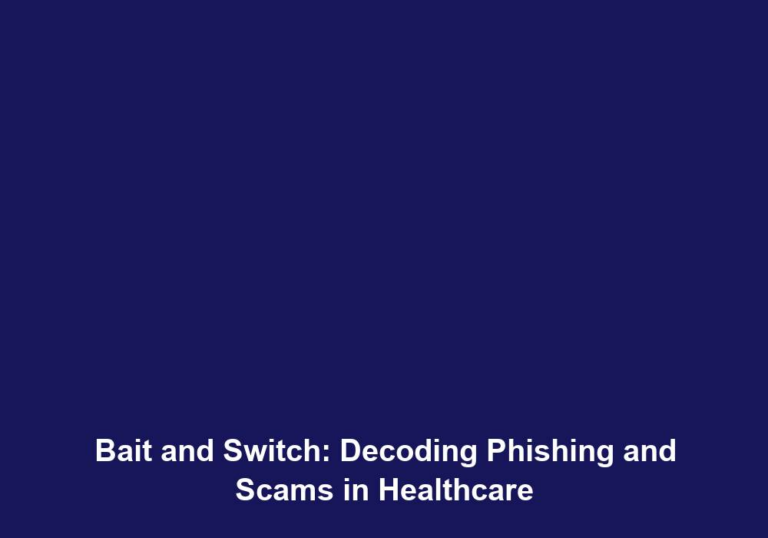Don’t Take the Bait: Recognizing and Counteracting Phishing in Health IT
In today’s technologically advanced world, the healthcare industry has embraced the use of information technology (IT) to streamline operations, improve patient care, and enhance overall efficiency. However, with these advancements, a new threat has emerged – phishing attacks. Phishing is a type of cyber-attack where malicious individuals attempt to deceive users into revealing sensitive information such as passwords, usernames, or financial details.
Phishing attacks in health IT can have severe consequences, including compromised patient data, financial losses, and damage to the reputation of healthcare providers. It is crucial for healthcare organizations and their employees to be aware of phishing techniques and adopt measures to protect sensitive information. In this article, we will discuss how to recognize and counteract phishing attacks in health IT.
Recognizing Phishing Attacks
Phishing attacks can occur through various channels, including emails, instant messages, social media, and even phone calls. To effectively combat phishing, it is essential to be able to recognize potential threats. Here are some signs that can help identify a phishing attack:
-
Sender’s email address: Pay attention to the email address of the sender. Phishing emails often mimic legitimate organizations, but the email address may be slightly different or contain typographical errors. For example, an email claiming to be from “bankofamerica.com” might have a misspelled domain like “bankofamrica.com” or “bankofamerica.net.”
-
Urgent or threatening language: Phishing emails often create a sense of urgency or fear to trick recipients into taking immediate action. Be cautious if the email insists on clicking on a link or providing personal information urgently. Phishers may use fear tactics, such as claiming that your account will be closed if you don’t respond immediately. Legitimate organizations typically do not use such tactics to communicate with their customers.
-
Poor grammar and spelling: Phishing emails are often riddled with grammatical errors and spelling mistakes. Legitimate organizations usually have professional communication standards. Keep an eye out for obvious mistakes, as they can be a red flag indicating a phishing attempt.
-
Suspicious attachments or links: Be cautious of any attachments or links in emails, especially if they come from unknown sources. Hovering over a link without clicking can reveal the actual destination, allowing you to assess its legitimacy. If the link appears to be leading to a different website than what it claims, or if it seems suspicious in any way, it’s best to avoid clicking on it.
-
Requests for personal information: Legitimate organizations seldom ask for personal information, such as passwords or social security numbers, via email. Avoid providing such sensitive details unless you are certain about the source’s authenticity. If an email asks you to confirm personal information, it’s safer to contact the organization directly through their official website or customer service hotline to verify the request.
Counteracting Phishing Attacks
Recognizing phishing attacks is the first step, but it is equally important to have strategies in place to counteract them effectively. Here are some measures that healthcare organizations and their employees can take to protect against phishing attacks:
1. Employee Education and Awareness
Proper training is crucial to raise awareness among employees about the dangers of phishing attacks. Healthcare organizations should conduct regular training sessions to educate employees about different types of phishing techniques, how to identify them, and what actions to take in case of a suspected phishing attempt. By providing employees with the necessary knowledge and tools, they become an essential line of defense against such attacks.
During training, employees should be educated about the latest phishing tactics, such as spear-phishing, which involves targeted attacks on specific individuals or departments within an organization. They should learn how to spot suspicious emails and what steps to take if they encounter one, such as reporting it to the IT department or the designated security team.
Additionally, organizations can create awareness by sharing real-life examples of phishing attempts and the consequences they can have. This helps employees understand the potential risks and motivates them to remain vigilant.
2. Implement Robust Email Filters and Firewalls
Healthcare organizations should invest in email filtering services and firewalls to detect and block phishing emails before they reach employees’ inboxes. These technologies use advanced algorithms and machine learning to identify potential phishing attempts based on various indicators. Regular updates and maintenance of these security systems are vital to ensure maximum protection.
Email filters can be configured to block suspicious attachments or links, preventing employees from accidentally exposing themselves to phishing attempts. Firewalls play a crucial role in preventing unauthorized access to the organization’s network, adding an extra layer of defense against phishing attacks.
3. Two-Factor Authentication (2FA)
Implementing two-factor authentication (2FA) adds an extra layer of security to user accounts. With 2FA, users are required to provide additional verification, such as a unique code sent to their mobile device, along with their username and password. This additional step makes it significantly harder for attackers to gain unauthorized access to sensitive information.
Healthcare organizations should encourage employees to enable 2FA for all their accounts, including email, electronic health record systems, and other platforms containing sensitive data. By implementing this additional security measure, organizations can greatly reduce the risk of successful phishing attacks.
4. Encourage Reporting
Healthcare organizations should create a culture of reporting suspected phishing attempts. Employees should be encouraged to report any suspicious emails or messages they encounter. By doing so, the organization’s IT department can investigate and take appropriate action, such as blocking the sender or conducting further security measures.
It is crucial to emphasize that reporting suspected phishing attempts is not a sign of weakness or incompetence, but rather a responsible and proactive approach to protecting the organization’s security. Employees should feel confident that their reports will be taken seriously and that they will not face any repercussions for reporting potential threats.
5. Keep Software Updated
Regularly updating software, including operating systems and applications, is crucial to protect against known vulnerabilities that cybercriminals may exploit. Software updates often include security patches that can prevent phishing attacks. Additionally, healthcare organizations should perform regular system scans to identify and mitigate potential risks.
Organizations should establish a robust patch management process to ensure timely updates across all systems and devices. This includes not only computers and servers but also medical devices and other IoT (Internet of Things) devices connected to the network. By staying up to date with software updates and security patches, organizations can minimize the risk of falling victim to phishing attacks.
6. Conduct Penetration Testing
Periodic penetration testing can help identify vulnerabilities in the organization’s IT infrastructure. By simulating real-world hacking attempts, healthcare organizations can assess their security measures and make necessary improvements to prevent successful phishing attacks.
Penetration testing involves ethical hackers attempting to exploit vulnerabilities in the organization’s systems, including email servers, network infrastructure, and applications. The results of these tests provide valuable insights into the organization’s security posture and highlight areas that require attention. By addressing these vulnerabilities promptly, organizations can strengthen their defenses against phishing attacks.
7. Data Backup and Recovery
Regularly backing up critical data ensures that even in the event of a successful phishing attack or another cybersecurity incident, healthcare organizations can recover their data without significant loss. Implementing an automated backup system that stores data off-site adds an extra layer of protection.
Organizations should develop a robust backup and recovery strategy that includes regular backups of all critical data, such as patient records, financial information, and operational data. Backups should be stored securely in an off-site location to protect against physical damage or theft. Regular testing of the backup system is also essential to ensure that data can be successfully restored when needed.
Conclusion
Phishing attacks pose a significant threat to the healthcare industry’s sensitive information and overall security. By recognizing the signs of phishing attempts and implementing robust security measures, healthcare organizations can protect themselves and their patients from the devastating consequences of these cyber-attacks. Proper employee education, email filtering, two-factor authentication, and regular system updates are just a few measures that can significantly mitigate the risks associated with phishing attacks. By staying vigilant and proactive, healthcare organizations can successfully counteract phishing in health IT and ensure the continued delivery of safe and secure patient care.


